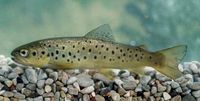Salmo Carpio.
Species description.
Salmo Carpio, commonly known as the carpione, is a critically endangered freshwater salmonid species endemic to Lake Garda, Italy’s largest lake. This highly localized trout is one of the few European salmonids confined entirely to a lacustrine (lake) environment and represents a unique evolutionary adaptation within the genus Salmo.
Taxonomy and Classification.
Salmo Carpio was first described in 1754 by Linnaeus. It belongs to the family Salmonidae, which includes trout, salmon, and chars. Historically, it was often lumped with Salmo trutta, but modern genetic and ecological studies confirm that S. Carpio is a distinct species, highly adapted to life in deep lakes.
Phylogenetic analysis suggests that Salmo Carpio likely evolved from post-glacial colonists related to the Mediterranean lineage of Salmo trutta, but became reproductively and ecologically isolated in Lake Garda, diverging significantly over time.
Physical Characteristics.
Salmo Carpio has several distinguishing features that separate it from its river-dwelling relatives:
- Streamlined body, adapted to open-water swimming
- Silvery coloration, often lacking prominent black or red spots seen in other Salmo species
- Shorter jaws and reduced dentition, consistent with a deep-water, pelagic lifestyle
- Reduced pigmentation and more slender profile in deep-water specimens
- Adults typically reach 30–50 cm in length, but larger individuals (up to 60 cm) have been recorded
These morphological features reflect adaptation to the cold, oxygen-rich depths of Lake Garda
Habitat and Distribution.
Salmo carpio is endemic to Lake Garda in northern Italy and is not found anywhere else in the world. It occupies:
- Deep pelagic waters of the central and northern basins of Lake Garda
- Depths typically between 100 and 200 meters, especially during warmer months
- Nearshore zones only briefly, during spawning migrations
Its highly restricted distribution and habitat specificity make it particularly vulnerable to environmental changes
Ecology and Life History.
Unlike most Salmo species, S. carpio is entirely lacustrine, completing its life cycle within the confines of a single lake. Its ecological and reproductive traits include:
- Feeding primarily on zooplankton (especially Daphnia) and small pelagic invertebrates
- Rarely feeding near the surface or along the shoreline
- Spawning in late winter or early spring (January to April), at depths of 50–200 m
- Using rocky or gravelly substrates for spawning, especially near underwater springs
Sexual maturity is reached at around 3–4 years, and the species is thought to be relatively long-lived. Its slow growth, low reproductive rate, and specialized spawning habitats increase its vulnerability to population declines
Conservation Status and Threats.
The IUCN Red List categorizes Salmo carpio as Critically Endangered, and the species is on the brink of extinction in the wild. Key threats include:
- Eutrophication – especially from agricultural runoff and urban waste, degrading water quality and spawning sites
- Overfishing – historically a major problem, although now legally protected
- Hybridization – with introduced Salmo trutta and stocked fish of uncertain genetic origin
- Climate change – altering temperature and oxygen levels in deep lake zones
- Loss of suitable spawning habitat – due to sedimentation and disturbance
Conservation programs have included captive breeding, restocking, and regulation of fishing, but the species remains highly endangered and dependent on active management
